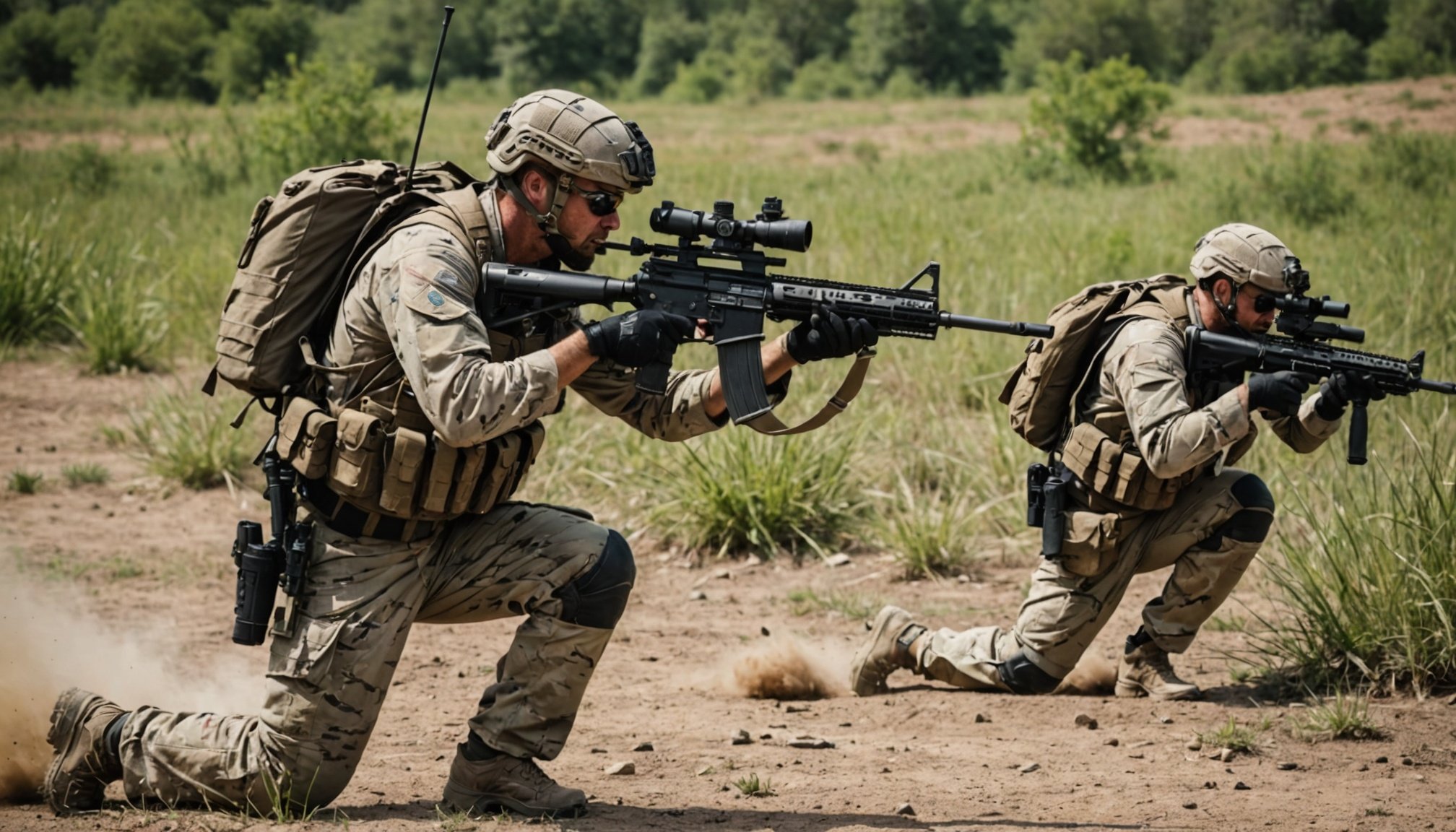Overview of Advanced Reality Technologies in Tactical Training
Advanced reality technologies are revolutionising the field of tactical training by providing immersive experiences that enhance learning and skill acquisition. These technologies encompass Virtual Reality (VR), Augmented Reality (AR), and Mixed Reality (MR), each offering unique applications and capabilities. VR creates a completely virtual environment for trainees to engage with, while AR overlays digital elements onto the real world. Mixed Reality combines aspects of both, blending real and virtual objects interactively.
The integration of these technologies in tactical training is significantly shifting traditional training methods. Historically reliant on physical drills and simulations, training now utilises virtual environments to recreate complex scenarios safely and efficiently. This enables trainees to practice decision-making, problem-solving, and strategic planning in realistic settings.
In the same genre : Mastering snooker: utilizing periodization strategies to enhance performance and prevent burnout
Statistics reveal an increasing adoption of these technologies, particularly in field sports. For example, a significant number of professional sports teams use VR to simulate game scenarios and improve player performance. In military and law enforcement training, AR and VR are employed to enhance situational awareness and refine tactical skills, offering controlled rehearsal environments that can replicate costly or logistically impossible scenarios.
The use of advanced reality technologies continues to grow, providing sophisticated and practical solutions to enhance tactical training effectiveness.
Impact of VR and AR on Athlete Performance
VR impact and AR benefits are revolutionising how athletes engage in training and competition. Through innovative simulations, these technologies enhance athlete performance by creating immersive environments where skills are honed with unparalleled precision.
VR’s role in training is transformative, as it allows athletes to experience real-game scenarios without leaving the practice facility. By replicating the intensity and unpredictability of actual games, VR offers a robust platform for skill development. Athletes can repeatedly practice specific situations, facilitating a deeper understanding and mastery of techniques.
In contrast, AR brings a different set of advantages, notably in improving situational awareness. By overlaying information onto the physical world, AR enriches an athlete’s perception in real-time. This heightened awareness enables quicker decision-making and a strategic edge during training sessions. For instance, an AR-enhanced visor could display critical stats mid-training, allowing for immediate adjustments and tactics refinement.
Empirical data supports the effectiveness of these technologies. Studies demonstrate notable improvements in reaction times, precision, and overall athlete performance post-technology integration. Such advancements highlight a significant shift toward tech-driven training methodologies. The evolution in sports analytics, driven by VR and AR, continues to push the boundaries of what’s achievable, offering promising enhancements for athletes striving to reach their peak potential.
Case Studies: Success Stories in Field Sports
Recent technology success stories in field sports have showcased the transformative impact of VR (Virtual Reality) and AR (Augmented Reality) in training routines. These innovations are revolutionising how athletes prepare, compete, and recover.
For instance, a renowned football team incorporated VR into their training sessions, allowing players to virtually experience matches before stepping onto the pitch. This advancement enabled athletes to hone their strategic thinking and decision-making skills within a simulated environment that closely mimics real-game situations.
Similarly, rugby squads have adopted AR to enhance training drills. By overlaying digital information onto physical environments, players can receive real-time feedback on their performance, leading to more precise adjustments and improved gameplay.
Enhanced Training Sessions
Detailed examples highlight the efficacy of these technologies. In one scenario, a field hockey team reported a 20% increase in reaction time and spatial awareness after integrating AR into their drills. Such enhancements foster an environment where athletes can immediately identify and correct weaknesses.
Performance Metrics
Statistical analysis supports these success stories. Before adopting VR/AR technologies, athletes in diverse sports demonstrated varying performance metrics. Post-implementation, there was a consistent trend of improved spatial awareness, reaction times, and strategic mastery, underscoring the tangible benefits these technological tools offer in field sports training.
Expert Opinions on Technology Integration in Sports
In the cutting-edge world of sports, expert insights shine a light on the critical role that technology plays today. Coaches embracing modern tech marvels highlight some intriguing sports technology opinions. For instance, renowned coach Alex Thomas contends that smart wearables and analytic tools offer unprecedented precision in monitoring athletic performance, elevating athletes to their peak potential.
Yet, opinions diverge when exploring training methodologies. Some experts express concern about athletes becoming overly reliant on data, potentially overshadowing the intuitive aspects honed by traditional methods. The balance, it appears, lies in combining innovation with time-tested techniques.
Technology’s relevance in sports training is indisputably immense. Innovations streamline processes and can customize training plans, addressing the individual needs of athletes. However, it’s not without drawbacks. Critics point out that extensive focus on metrics can lead to information overload, potentially hindering performance rather than enhancing it.
To fully understand the pros and cons, it’s essential to assess how each method impacts performance. While technology offers significant advantages like data accuracy and injury prediction, traditional coaching provides emotional insight and motivation. This dual approach could well shape the future of sports, making it vital for experts to continuously evaluate these sports technology opinions.
Benefits and Drawbacks of Cutting-edge Technologies
In the realm of sports training, integrating virtual reality (VR) and augmented reality (AR) presents numerous benefits. These technologies provide immersive training environments, enhancing athlete performance by simulating real-world scenarios. VR can offer risk-free training, allowing athletes to practice without the potential for injury. This technological advancement assists in refining skills and decision-making abilities under simulated pressure, proving invaluable in sports training.
Despite these advantages, there are noteworthy drawbacks. The cost of implementing VR and AR can be prohibitive for some teams, limiting access to this advanced training method. Additionally, over-reliance on technology may lead athletes to neglect essential physical training, which remains crucial for endurance and strength building. These drawbacks highlight the need for a balanced approach in sports training regimens.
Athletes and coaches must address the challenge of maintaining equilibrium between embracing these cutting-edge technologies and ensuring traditional training forms are not sidelined. Achieving this balance can maximize the benefits of technology while mitigating potential risks. For effective integration, technology should complement rather than replace physical efforts, helping athletes overcome sports training challenges while preparing them comprehensively for competitive scenarios. By thoughtfully combining both aspects, teams can harness technology’s full potential in training environments.
Future Trends in Tactical Training Technologies
As the world of sports continually evolves, so does the landscape of tactical training technologies. The next decade promises exciting possibilities, with innovations in sports technology shaping the way athletes train and compete. One emerging trend involves AI and wearables, which are expected to play a significant role in personalised training regimes. AI systems can analyse extensive data sets to optimise athletic performance, offering real-time feedback and suggestions tailored to each individual.
The future also holds immense potential for VR and AR in sports training. These technologies are anticipated to offer immersive environments that can simulate real-world challenges, helping athletes develop tactical awareness without stepping onto the field. As VR and AR become more advanced, they are likely to become integral in honing players’ skills and strategies.
Additionally, the increasing role of data analysis and feedback mechanisms is expected to revolutionise training practices. Detailed insights derived from data can provide coaches with a deeper understanding of an athlete’s performance, aiding in identifying areas for improvement. As tactical training evolves, these innovations are aimed at enhancing not only the physical but also the strategic elements of sports, ensuring athletes are better prepared for future challenges.











